Herb Spirals
Herb spirals are beautiful, productive, righteous installations -- popular in permaculture circles, but little known in mainstream garden design
Herb Spirals
Herb spirals are beautiful, productive, righteous installations -- popular in permaculture circles, but little known in mainstream garden design
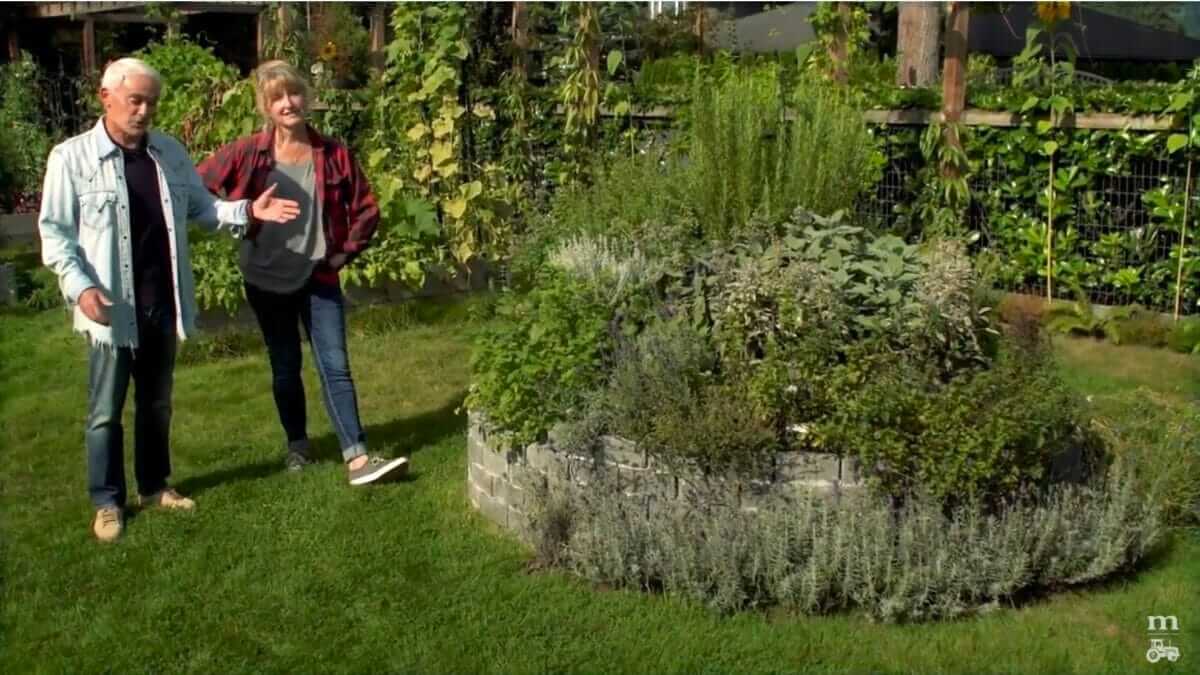
Modern Farmer Publisher Frank Giustra sees nature's perfection in the Fibonacci Sequence inspired herb spiral
If I had huge aspirations but a small outdoor space, the one thing I would build to guarantee the biggest return on investment would be an herb spiral. Herb spirals are beautiful, productive, righteous installations — popular in permaculture circles, but little known in mainstream garden design. I think of my herb spiral as a one-stop culinary trip around the world. Its many microclimates allow me to grow native and exotic herbs fundamental to many ethnic cuisines, and all within a very small footprint. In a space crunch, there is no reason why dwarf tomatoes, lettuces, radishes, beets and other vegetables couldn’t be planted among the herbs. I planted surplus romaine and buttercrunch in my spiral, and it thrived.
My spiral is about 7ft wide (2 metres) and 1 metre (3+ feet) tall. If the circle were flat, the plantable area would be about 38.5 square feet, but because the winding 14″-18″ wide bed is linear, running up at an incline to the centre top of the circle in a spiral pattern, there is a gain not just in real estate area, but in opportunity. From a bird’s eye view, an herb spiral looks very much like a snail or nautilus shell, shapes that are based on what is known as nature’s sacred geometry. Sacred geometry reflects the universe, its pure forms and the relationship between nature and man, the parts and the whole. While spirals in nature tend to follow the golden ratio, also knows as the Golden Ratio (Phi) or the Fibonacci Sequence in their rates of expansion, my herb spiral claims no such accuracy. Like all permaculture installations and systems, we mimic nature’s logic but we cannot match her accuracy or precision.
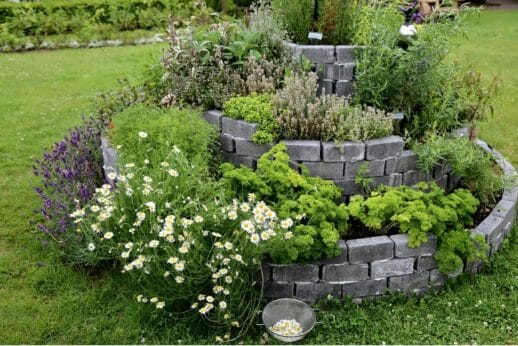
Permaculture co-found Bill Mollison formalized the design and construction of herb spirals, but it it was likely not his original idea. There is no ‘absolute’ right way to build an herb spiral, though Mollison’s recommended size and proportions do work almost magically for me. I do very little to maintain the plants in my spiral, yet they are so prolific that very many harvests are required over the season. I hang great bundles of herbs from the kitchen library to dry, for use in culinary and medicinal applications, and I share them with neighbours.
The premise behind an herb spiral is to create diverse growing environments for culinary and medicinal herbs at various elevations, utilizing various soil/drainage conditions, and various exposures to sun, shade, wind, frost, etc., and to utilize gentle slopes and bulk soil to slow down the natural movement of water, leaving just enough of it where it is needed, to maintain ideal growing conditions. With a little planning and patience, you can grow and harvest everything from angelica to watercress, and maintain a small bog or pond at ground level, on the deep shade side of the installation. I opted for a bog pseudo-creekbed like area, because we live on the edge of a temperate rainforest, and a pond would only attract raptors, racoons and coyotes.
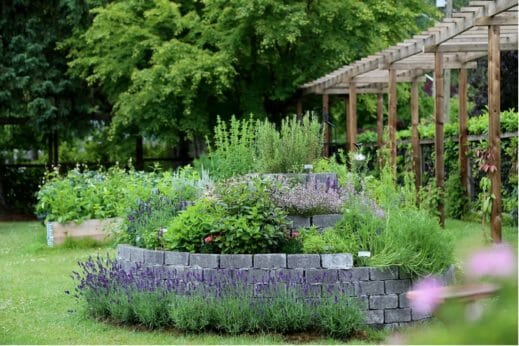
Authentic permaculture herb spirals utilize stones and small logs found on site, and/or perhaps recycled bottles, broken cement, or found materials. In planning my front yard situated herb spiral, I had to consider neighborhood culture, decades old community design considerations, and also my neighbours (views and happiness). I built the spiral using traditional principles and scale, but with materials that were more sympathetic to established building and landscape architecture. Tumbled grey concrete bricks, diverted from another building site were put to good use in my garden and fit in nicely with the old bones of our 72 year-old home. I used mis-matched century-old red brick left over from a garden edging project, to fortify the hidden centre column of the structure, and to reduce the amount of higher-quality brick that I would need to commit overall.
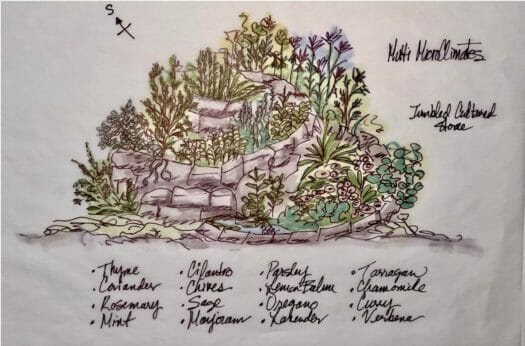
I did use some mortar, but very little, and only to ‘glue’ the horizontal surface of the bricks to one another. I left the vertical seams open for drainage, for migration of insects and tiny creatures, and to accelerate the growth of moss. The chore of removing moss from the driveway pavers over the winter, will become an efficient forage for the spiral. I plan to fill most of the vertical seams with moss, which should help the spiral retain water, and add an element of age, rather quickly.
Ideally and typically, herb spiral are built within permaculture zone one, within 10 feet of the kitchen door. This makes sense of course, as you will likely want to run out while cooking, for a snip of this or that herb. We moved into our home 20 years ago, and there was nothing but patio outside our kitchen doors. The back lawn was committed to swings and a small playing field, plus it is rather shady where the mossy grass is. Out front however, we get full sun almost all day throughout the summer, and we had plenty of room for an herb spiral. The fact that it would be 150ft or so from the kitchen door (permaculture zone two or three, typically), didn’t deter me. I love it so much, I am happy to make the trip out, rain or shine. Urban permaculture is after all, about adapting and re-imagining, doing your best to follow rural permaculture principles and ethics in imperfect conditions, and celebrating small victories.
My front yard herb spiral is far from my kitchen door but I’m happy to make the trip, visiting beds en-route
I started my build on bare lawn that had been ravaged by chafer beetles, and dug-up by raccoons. Using a string and bamboo compass of sorts to delineate the circle, I dug up and composted the sod. I laid about six inches of round drainage rock (not split gravel as it fits together tightly which is counter-intuitive for drainage), and leveled it out to grade-more-or-less. If you live in an area where ants are common, using sand as a base may send your spiral tilting and sinking in short order. After dampening the gravel, I laid a two-inch wide strip of thick sand-based mortar on which to lay my first course of damp bricks (damp, bricks stick together much better than dry), adjusting accordingly to fit whole bricks only. I then laid two consecutive layers, alternating the seams in a traditional brick pattern.
I let the bricks set for about an hour, and then used trial and error, creativity, and simple intuition to dry-stack design the spiral, ensuring that the bottom end of the ‘spiral’ ended on the north bottom side of the structure, where excess water would spill out in the boggy area. You could quite easily look at the structure I built, and create one of your own in a similar fashion, or elongate it perhaps into an oval. Once I was satisfied with my dry-stack, I deconstructed it, created a plan on paper, counting bricks and noting steps and orientation, then broke the spiral down and began building in ernest. I used lengths of 1×10 left over from building the garden beds plus two long levels, to ensure that I didn’t go off kilter. It was fun and easy to build.
Once built, I added a good six inches of drain rock around the perimeter ‘beds’ and took advantage of the interior column, to get rid of some large rocks and broken bricks that has been sitting around getting in the way. I knew which herbs I wanted to plant, and I left them guide me in creating unique soil and drainage conditions as I worked my way around the spiral, from south to east, to north and back to south; from bottom to top, and from exterior edge to the centre. I kept in mind that the vertical spaces between the bricks would weep moisture from the centre outward and also down, and I knew too that the thermal mass of the bricks would collect, reflect, and retain solar energy during the day, feeding it gently back to surrounding plants at night.
I used only large and small rocks, and broken brick for drainage, and organic compost to fill. In some places, where I wanted to place plants like lavender that don’t like wet feet, I mixed organic compost and small round drain rocks 50/50. In front of the spiral, facing south, I created as 8″ high berm against the thermal mass of the brick, and planted sun-loving lavender to attract pollinators.
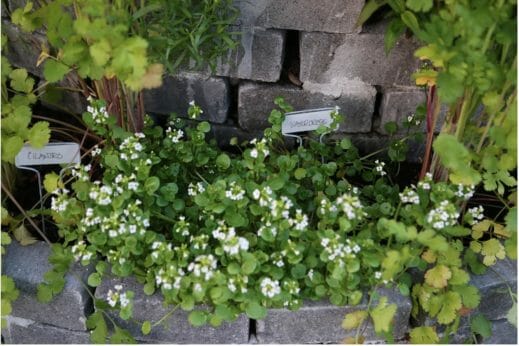
I moved many herbs from their pots on the sunny areas of the back patio, to the herb spiral, I grew others from seed, and I purchased some from a local nursery. Before committing to planting, I laid the pots where I thought the herbs would thrive, and set about filling in the blank spaces in between with herbs or pollinator attracting perennials like dwarf salvia, to suit. I built and planted the herb spiral in early May, and after just two months it was full and lush and looked as though it had been there for years. With all but the summer savory, the plants thrived. Summer savory is an annual, known to fade quickly and dislike wet spring weather, which we certainly experienced this year.
Every herb spiral would be different of course, but for the record, mine contains, lavender, three varieties of oregano, six varieties of thyme, chamomile, creeping savory, winter savory, summer savory, three varieties of sage, French tarragon, Vietnamese Coriander, Italian and curly parsley, sweet marjoram, Tuscan rosemary, lemon balm, lemon verbena, dwarf curry, and seven varieties of mint. Mediterranean herbs like rosemary, woody thyme and lavender were sited for sunlight, heat and optimal drainage, while tender herbs like parsley and cilantro were sited for part sun and a bit more moisture. Vietnamese did well in its mid-level north bed where its roots could stay cool and moist while its leaves drank in the sun. The oreganos were planted mid-level facing west, and they sorted themselves, reaching and hiding from the sun as suited them. Three varieties of sage, planted mid-level south, self-sorted as well. Nature is so clever.
To avoid having the mint take over, I planted each variety in bottomless pots, and I keep an eye on runners. At the far bottom north of the spiral, a small watercress pond happily collects spillwater before it flows over ultimately, into a a grassy bog containing the highly medicinal herb, Labrador Tea. I don’t include basil in the spiral because it is quite fragile, prone to burning and wilting, but primarily because I companion plant a huge amount of it with my tomatoes – enough for a winter’s worth of frozen pesto.
Just a few weeks ago, I harvested the last of the tarragon for vinegar, cut a final dozen or so bouquets of mint, lemon balm, oregano, and savory for drying, and harvested about half a bushel of rosemary destined for the dehydrator. I covered the rosemary and Vietnamese coriander stubble with a few inches of compost and then mulched it with clean garden straw. I hope to keep harvesting the winter savory over the cold months, but still mulched its crown with straw, just to be safe. It’s hard to say whether or not the hardy perennial herbs will return in full glory next spring. It will depend on cold and thaw cycles, the quality and measure of wind coming down from the snowy mountains, and the amount of snow (wet snow in particular), that nature sends us. I’ve done what I could and will hope for the best.

Follow us
This work is licensed under a Creative Commons Attribution-NoDerivatives 4.0 International License.
Want to republish a Modern Farmer story?
We are happy for Modern Farmer stories to be shared, and encourage you to republish our articles for your audience. When doing so, we ask that you follow these guidelines:
Please credit us and our writers
For the author byline, please use “Author Name, Modern Farmer.” At the top of our stories, if on the web, please include this text and link: “This story was originally published by Modern Farmer.”
Please make sure to include a link back to either our home page or the article URL.
At the bottom of the story, please include the following text:
“Modern Farmer is a nonprofit initiative dedicated to raising awareness and catalyzing action at the intersection of food, agriculture, and society. Read more at <link>Modern Farmer</link>.”
Use our widget
We’d like to be able to track our stories, so we ask that if you republish our content, you do so using our widget (located on the left hand side of the article). The HTML code has a built-in tracker that tells us the data and domain where the story was published, as well as view counts.
Check the image requirements
It’s your responsibility to confirm you're licensed to republish images in our articles. Some images, such as those from commercial providers, don't allow their images to be republished without permission or payment. Copyright terms are generally listed in the image caption and attribution. You are welcome to omit our images or substitute with your own. Charts and interactive graphics follow the same rules.
Don’t change too much. Or, ask us first.
Articles must be republished in their entirety. It’s okay to change references to time (“today” to “yesterday”) or location (“Iowa City, IA” to “here”). But please keep everything else the same.
If you feel strongly that a more material edit needs to be made, get in touch with us at [email protected]. We’re happy to discuss it with the original author, but we must have prior approval for changes before publication.
Special cases
Extracts. You may run the first few lines or paragraphs of the article and then say: “Read the full article at Modern Farmer” with a link back to the original article.
Quotes. You may quote authors provided you include a link back to the article URL.
Translations. These require writer approval. To inquire about translation of a Modern Farmer article, contact us at [email protected]
Signed consent / copyright release forms. These are not required, provided you are following these guidelines.
Print. Articles can be republished in print under these same rules, with the exception that you do not need to include the links.
Tag us
When sharing the story on social media, please tag us using the following: - Twitter (@ModFarm) - Facebook (@ModernFarmerMedia) - Instagram (@modfarm)
Use our content respectfully
Modern Farmer is a nonprofit and as such we share our content for free and in good faith in order to reach new audiences. Respectfully,
No selling ads against our stories. It’s okay to put our stories on pages with ads.
Don’t republish our material wholesale, or automatically; you need to select stories to be republished individually.
You have no rights to sell, license, syndicate, or otherwise represent yourself as the authorized owner of our material to any third parties. This means that you cannot actively publish or submit our work for syndication to third party platforms or apps like Apple News or Google News. We understand that publishers cannot fully control when certain third parties automatically summarize or crawl content from publishers’ own sites.
Keep in touch
We want to hear from you if you love Modern Farmer content, have a collaboration idea, or anything else to share. As a nonprofit outlet, we work in service of our community and are always open to comments, feedback, and ideas. Contact us at [email protected].by Laura Marie Neubert, Modern Farmer
November 20, 2020
Modern Farmer Weekly
Solutions Hub
Innovations, ideas and inspiration. Actionable solutions for a resilient food system.
ExploreExplore other topics
Share With Us
We want to hear from Modern Farmer readers who have thoughtful commentary, actionable solutions, or helpful ideas to share.
SubmitNecessary cookies are absolutely essential for the website to function properly. This category only includes cookies that ensures basic functionalities and security features of the website. These cookies do not store any personal information.
Any cookies that may not be particularly necessary for the website to function and are used specifically to collect user personal data via analytics, ads, other embedded contents are termed as non-necessary cookies.
This is such a dinamite idea. Esp being in southwest FL, and having many types of ants!!!
Will start collecting the items I need and hope to get this going. Thx!
To the Author of this Article: I’m wondering where you live and how well most herbs winter over. I live in Atlantic Canada (Nova Scotia) and plan to build a spiral herb garden for next summer. I’ve often wondered how perennial herbs do in cold winter weather. Do they need to be covered or do they just pop back up in spring? I love all your ideas, well done.
I was wondering if you could tell me approx how many bricks you used to build this. I like your design very much and would like to try to replicate it.
I’ve always been fascinated by these structures when I’ve seen photos of them. But didn’t know where to even begin. Thank you so much for sharing both your method and lots of photos which illustrate how it is possible by using elevation to create different “mini” grow zones in a relatively small footprint. I’m inspired!